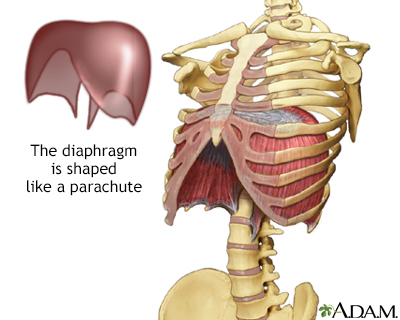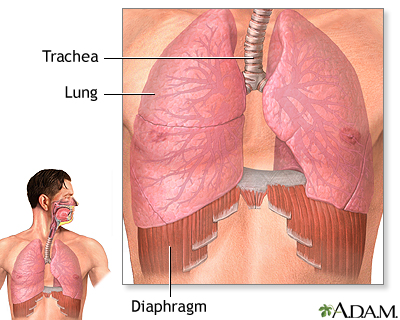Rapid shallow breathing
Tachypnea; Breathing - rapid and shallow; Fast shallow breathing; Respiratory rate - rapid and shallow
A normal breathing rate for an adult at rest is 12 to 20 breaths per minute. For an infant, a normal rate is 30 to 60 breaths per minute.
Tachypnea is the term that your health care provider uses to describe your breathing if it is too fast, especially if you have fast, shallow breathing from a lung disease or other medical cause.
The term hyperventilation is usually used if you are taking rapid, deep breaths. This can be due to lung disease or because of anxiety or panic. The terms are sometimes used interchangeably.

The diaphragm is a thin dome-shaped muscle which separates the thoracic cavity (lungs and heart) from the abdominal cavity (intestines, stomach, liver, etc.). It is involved in respiration, drawing downward in the chest on inhalation, and pushing upward in exhalation.

The diaphragm, located below the lungs, is the major muscle of respiration. It is a large, dome-shaped muscle that contracts rhythmically and continually, and most of the time, involuntarily. Upon inhalation, the diaphragm contracts and flattens and the chest cavity enlarges. This contraction creates a vacuum, which pulls air into the lungs. Upon exhalation, the diaphragm relaxes and returns to its domelike shape, and air is forced out of the lungs.

Air is breathed in through the nasal passageways, travels through the trachea and bronchi to the lungs.
Causes
Shallow, rapid breathing has many possible medical causes, including:
- Asthma
- Blood clot in an artery in the lung
- Choking
- Chronic obstructive pulmonary disease (COPD) and other chronic lung diseases
- Heart failure
- Infection in the smallest air passages of the lungs in children (bronchiolitis)
- Pneumonia or other lung infection
- Transient tachypnea of the newborn
- Anxiety and panic
- Other serious lung disease, such as interstitial lung disease or bronchiectasis
- Diabetic ketoacidosis or other causes of acid buildup in the body are often associated with rapid, very deep breaths
Home Care
Rapid, shallow breathing should not be treated at home. It is generally considered a medical emergency (unless anxiety is the only cause).
If you have asthma or COPD, use your inhaler or nebulizer medicines as prescribed by your provider. You may still need to be checked by a provider right away if you have rapid shallow breathing. Your provider will explain when it is important to go to the emergency room.
When to Contact a Medical Professional
Call 911 or the local emergency number, or go to the emergency room if you are breathing rapidly and you have:
- Bluish or grayish color to the skin, nails, gums, lips, or the area around the eyes (cyanosis)
- Chest pain
- Chest wall is pulling in with each breath (intercostal retractions)
- Fever
- Labored or difficult breathing
- Never had rapid breathing before
- Symptoms that are getting more severe
What to Expect at Your Office Visit
Your provider will do a thorough exam of your heart, lungs, abdomen, and head and neck.
Tests that may be ordered include:
- Arterial blood gas and pulse oximetry to check your oxygen level
- Chest x-ray
- Chest CT scan
- Complete blood count (CBC) and blood chemistries
- Electrocardiogram (ECG)
- Ventilation/perfusion scan of your lungs
- Comprehensive metabolic panel to check the body's chemical balance and metabolism
Treatment will depend on the underlying cause of the rapid breathing. Treatment may include oxygen if your oxygen level is too low. If you are having an asthma or a COPD attack, you'll receive treatment to stop the attack.
Many times, this evaluation will need to be done in an emergency room setting.
References
Kraft M. Approach to the patient with respiratory disease. In: Goldman L, Cooney KA, eds. Goldman-Cecil Medicine. 27th ed. Philadelphia, PA: Elsevier; 2024:chap 77.
McGee S. Respiratory rate and abnormal breathing patterns. In: McGee S, ed. Evidence-Based Physical Diagnosis. 5th ed. Philadelphia, PA: Elsevier; 2022:chap 19.
Version Info
Version: 2.0
Last reviewed on: 4/1/2025
Reviewed by: Frank D. Brodkey, MD, FCCM, Associate Professor, Section of Pulmonary and Critical Care Medicine, University of Wisconsin School of Medicine and Public Health, Madison, WI. Also reviewed by David C. Dugdale, MD, Medical Director, Brenda Conaway, Editorial Director, and the A.D.A.M. Editorial team.
